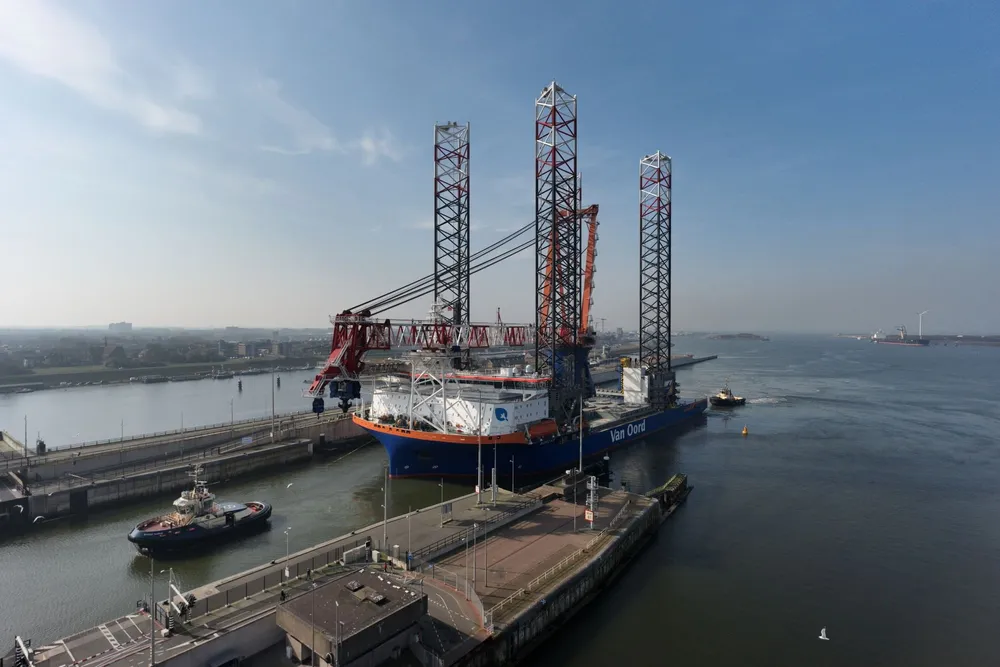Shipowners sitting pretty as wind developers scramble for 'small fleet'
Average lead times for specialist offshore wind turbine vessels could stretch beyond 3.5 years, study suggests

Lead times for the installation of offshore wind turbines and foundations are soaring to record levels amid a tightening market for vessels, a new study has shown.
The lead time metric — which refers to the duration between the firm contract award and the start of the installation campaign — is a key indicator of how early developers must secure vessel availability to keep their projects on schedule.
A short lead time suggests a more flexible market with readily available assets, while an increasing lead time indicates growing competition for a limited pool of specialised vessels, with obvious implications for day rates charged for their services.
A new study by offshore wind market intelligence firm Spinergie shows that lead times have been relentlessly rising over almost a decade, as the number of high-specification vessels fails to keep up with the "rising complexity" of offshore wind projects, especially the shift toward larger wind turbines.
Foundations pivotal
In 2016, the average lead time for foundations was just over a year, but this more than doubled to 2.5 years by 2024, the study found.
By 2028, lead times will be surpassing 3.3 years, it calculated due, chiefly, to the shift toward larger and heavier foundations designed to support turbines exceeding 15MW.
"As the components become more challenging to install, the industry requires high-capacity vessels with greater lifting capabilities, deeper operational drafts, and enhanced stability," the study observed.
While some companies have been building new higher capacity vessels for foundations, Spinergie showed that there will not be enough of them to reverse the sharply rising metric.
The trend was exacerbated by a growing portion of the existing fleet requiring extensive retrofits to keep up with technical demand, restricting further the number of available assets capable of meeting the larger installation demands.
Spinergie also pointed out that delays in foundation campaigns often have a domino effect, postponing turbine installations and lengthening project timelines.
Spinergie flagged the decade-end demand peak that is being caused by the bunching of many government offshore wind targets.
According to the research, a majority of planned projects will require foundations in excess of 2,000 tonnes by then, but found only 25 vessels built or announced capable of installing them.
"The reality facing project developers is that by this year, the fleet of vessels capable of installing the required foundations will be small." Spinergie stated.
Wind turbine installation
While foundations can be carried out by a range of heavy-lift vessels, turbine installation is dependent on jack-ups and faces an even tighter market, Spinergie suggested.
The average lead time for turbine installation contracts increased by approximately 15% annually, rising from 1.5 years in 2016 to at least 3.5 years by 2028.
These next-generation vessels must not only have sufficient crane capacity and deck space to accommodate the latest turbine model, but also operate efficiently in deeper waters and harsher conditions. With a limited number of them available, bottlenecks are expected to become more pronounced.
"The steady increase in contract lead times highlights the mounting pressure on offshore wind installation campaigns. As turbine sizes grow and foundation designs evolve, the demand for high-capacity vessels is intensifying, creating a tight market where securing the right assets well in advance is crucial," the report stated .
"Installation vessels also operate on back-to-back contracts, meaning that any setback in one project can ripple through the entire pipeline, impacting multiple wind farms. Additionally, projects are growing in scale, with larger campaigns requiring more installation days, naturally extending lead times even further," it stated.
To mitigate the risk of vessel shortages, escalating day rates and costly delays, developers are reshaping contracting strategies, Spinergie noted.
A key strategy is simply securing installation assets much earlier in the project timeline or securing vessels through preferred agreements in order to guarantee access to the right vessels, avoid last-minute availability constraints and control costs in an increasingly competitive market.
In the case of the Wind Ace, Spinergie noted that this next-generation vessel for both foundations and turbines has secured contracts until 2031 although it will not even be delivered by China's Cosco shipyard until 2026.
Spinergie does not expect the market to ease any time soon.
"As turbine sizes continue to increase, and the demand for next-generation jack-ups surpasses the available fleet, lead times for turbine installation campaigns are expected to keep growing, reinforcing the need for long-term planning and early contracting," it stated.
By 2030, Sinergie predicted that the offshore wind landscape will be dominated by larger turbines, with 75% of installations featuring models exceeding 14MW.
"This shift places mounting pressure on the jack-up vessel market, as 27 vessels built or announced will have the crane capacity (by lifting and hook height) to handle these next-generation turbines," the report said.
"With turbine sizes increasing faster than fleet expansion, securing suitable installation assets is becoming a growing challenge for developers.
Shipyard slots
Spinergie acknowledged that building new heavy-lift vessels requires a longer timeline than some other offshore service vessels due to their complex design and engineering phases and specialised equipment
"From the moment a shipyard reservation is made, it can take four years before the vessel is operational, meaning orders placed today will not see delivery until 2029-2030 at the earliest," the report stated.
This timeline means it is generally not possible to defer newbuild contracting waiting until after a final investment decision on a wind farm the vessel would almost certainly affect schedules.
(Copyright)